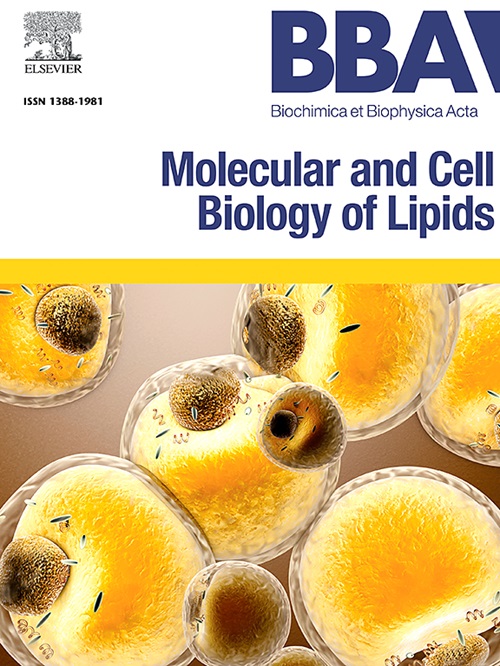Tumor necrosis factor alpha-induced activation of SREBP2 promotes cholesterol biosynthesis in cholestasis
IF 3.3
2区 生物学
Q2 BIOCHEMISTRY & MOLECULAR BIOLOGY
Biochimica et biophysica acta. Molecular and cell biology of lipids
Pub Date : 2025-06-06
DOI:10.1016/j.bbalip.2025.159642
引用次数: 0
Abstract
Background and aims
Cholestasis is frequently associated with lipid metabolism disorders, elevated cholesterol levels and disruptions in bile acid homeostasis. Nevertheless, the mechanisms underlying cholesterol elevation in cholestasis remain inadequately understood. This study aims to investigate alterations in cholesterol levels and potential mechanisms in mouse models of cholestasis. Additionally, we evaluate the therapeutic potential of Sterol Regulatory Element Binding Protein 2 (SREBP2), a key transcription factor regulating cholesterol synthesis, in treating cholestasis.
Approaches and results
We developed mouse models of cholestasis using bile duct ligation (BDL) and a 0.1 % 3,5-diethoxycarbonyl-1,4-dihydrocollidine (DDC) diet. Serum and liver samples were collected for analysis. The human hepatoma cell line PLC/RPF/5 was used for mechanistic studies. Cholestatic mice exhibited significantly elevated total cholesterol levels in serum and liver. Gene expression analysis revealed marked upregulation of cholesterol biosynthesis-related genes and the transcription factor SREBP2. Mechanistic studies indicated that TNFα promotes cholesterol synthesis by activating SREBP2 and its downstream target genes. To validate these findings in vivo, we employed the BDL mouse model and treated the mice with Fatostatin, a known SREBP2 inhibitor. Administration of Fatostatin significantly reduced serum ALT, ALP and hepatic cholesterol levels in the BDL mouse model, suggesting a potential therapeutic effect against cholestatic liver injury.
Conclusions
This study concludes that the activation of the NF-κB signaling pathway by TNFα leads to increased expression of SREBP2 in cholestatic mouse model. These findings indicate that the TNFα/NF-κB/SREBP2 pathway could serve as a promising target for treating cholestasis.
肿瘤坏死因子α诱导的SREBP2激活促进胆固醇淤积的生物合成
背景和目的胆汁淤积通常与脂质代谢紊乱、胆固醇水平升高和胆汁酸稳态破坏有关。然而,胆固醇升高的机制在胆汁淤积症中仍未得到充分的了解。本研究旨在探讨小鼠胆汁淤积模型中胆固醇水平的改变及其潜在机制。此外,我们评估了甾醇调节元件结合蛋白2 (SREBP2)在治疗胆汁淤积中的治疗潜力,SREBP2是调节胆固醇合成的关键转录因子。方法和结果我们采用胆管结扎(BDL)和0.1% 3,5-二氧羰基-1,4-二氢碰撞碱(DDC)饮食建立了胆汁淤积小鼠模型。采集血清和肝脏样本进行分析。采用人肝癌细胞株PLC/RPF/5进行机制研究。胆汁淤积小鼠血清和肝脏中总胆固醇水平显著升高。基因表达分析显示胆固醇生物合成相关基因和转录因子SREBP2显著上调。机制研究表明TNFα通过激活SREBP2及其下游靶基因促进胆固醇合成。为了在体内验证这些发现,我们采用了BDL小鼠模型,并用Fatostatin(一种已知的SREBP2抑制剂)治疗小鼠。在BDL小鼠模型中,给予Fatostatin可显著降低血清ALT、ALP和肝脏胆固醇水平,提示其对胆汁淤积性肝损伤具有潜在的治疗作用。结论TNFα激活NF-κB信号通路可导致胆汁淤积小鼠模型中SREBP2的表达升高。这些发现表明,TNFα/NF-κB/SREBP2通路可能是治疗胆汁淤积的一个有希望的靶点。
本文章由计算机程序翻译,如有差异,请以英文原文为准。
求助全文
约1分钟内获得全文
求助全文
来源期刊
CiteScore
11.00
自引率
2.10%
发文量
109
审稿时长
53 days
期刊介绍:
BBA Molecular and Cell Biology of Lipids publishes papers on original research dealing with novel aspects of molecular genetics related to the lipidome, the biosynthesis of lipids, the role of lipids in cells and whole organisms, the regulation of lipid metabolism and function, and lipidomics in all organisms. Manuscripts should significantly advance the understanding of the molecular mechanisms underlying biological processes in which lipids are involved. Papers detailing novel methodology must report significant biochemical, molecular, or functional insight in the area of lipids.

 求助内容:
求助内容: 应助结果提醒方式:
应助结果提醒方式:


